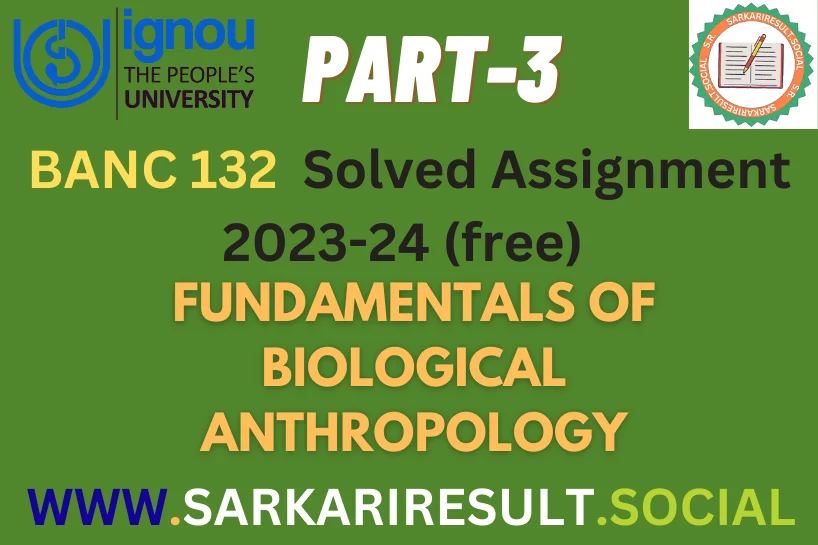BANC-132 IGNOU Solved Assignment 2023-24 (free) Part 3

BANC-132 IGNOU Solved Assignment 2023-24 (free) Part 3
“Conclude your journey through Biological Anthropology of BANC-132. This is the Solved Assignment 2023-24 (free) Part 3. In this section, you’ll explore various topics with concise responses of about 100 words each.

Q.6 Adaptation to High Altitude.
Ans. Adaptation to high altitude involves physiological changes that help the body cope with reduced oxygen levels at higher elevations. Key adaptations include increased red blood cell production (polycythemia) to carry more oxygen, enhanced lung capacity and efficiency, and a higher metabolic rate. Over time, people living at high altitudes may develop unique genetic traits, like increased hemoglobin levels. These adaptations help improve oxygen uptake, aiding survival in low-oxygen environments. Visitors to high altitudes often experience altitude sickness due to their bodies not having fully adapted. Studying high-altitude populations sheds light on human evolutionary responses to challenging environmental conditions.
Q.7 Dermatoglyphics
BANC-132 Solved Assignment 2023-24 (free) Part 1
Ans. Dermatoglyphics is the study of unique patterns and ridges found on the skin, primarily on the fingertips, palms, toes, and soles. These patterns include fingerprints, palm prints, and footprints. Dermatoglyphics are formed during fetal development and remain largely unchanged throughout a person’s life. They are valuable in forensic science for identifying individuals and have applications in genetics and anthropology. In the field of biology, dermatoglyphics can provide insights into the genetic basis of skin patterns and their variations among populations. Additionally, some believe dermatoglyphics can offer clues about an individual’s intelligence, personality, and potential health traits, although these claims are often considered pseudoscientific.
Q.8 Speciation.
Ans. Speciation is the process by which new and distinct species evolve from a common ancestor. It occurs when populations of a species become genetically isolated and diverge over time. This isolation can result from geographical barriers, reproductive barriers, or ecological differences. As populations accumulate genetic changes through mutation, natural selection, and genetic drift, they become increasingly distinct from one another. Eventually, they may no longer be able to interbreed successfully, leading to the formation of two separate species. Speciation is a fundamental driver of biodiversity, allowing life to adapt and evolve to various ecological niches, and is a central concept in the study of evolution.
Q.9 ABO Blood group system.
Ans. The ABO blood group system is a classification of human blood based on the presence or absence of specific antigens on the surface of red blood cells. It categorizes blood into four main groups: A, B, AB, and O. Group A has A antigens, B has B antigens, AB has both, and O has neither. The immune system produces antibodies against the antigens not present on an individual’s red blood cells. For example, type A blood has anti-B antibodies. This system is vital for blood transfusions, organ transplants, and understanding genetic inheritance patterns. ABO blood typing plays a crucial role in ensuring compatibility and preventing transfusion reactions.
Q.10 Opposable thumb and manual dexterity.
Ans. An opposable thumb is a unique feature of primates, including humans, that enables a thumb to move freely and touch the other fingers, allowing for precision grip and manual dexterity. This adaptation is essential for various tasks like grasping objects, tool use, and fine motor skills. Opposable thumbs grant humans the ability to manipulate objects with precision, making activities like writing, drawing, and intricate tool-making possible. This characteristic distinguishes primates from many other animals and has played a pivotal role in the development of complex societies, advanced technology, and the evolution of human civilization.
BANC-132 Solved Assignment 2023-24 (free) Part 2
Q.11 Longitudinal method of studying human growth.
Ans. The longitudinal method of studying human growth involves observing and collecting data from the same individuals over an extended period. Researchers track their development from infancy or childhood into adulthood, examining physical, cognitive, and emotional changes over time. This method provides valuable insights into individual growth trajectories, allowing for the detection of developmental patterns, stability, and change within a single subject. Longitudinal studies are particularly useful for studying developmental trends, lifespan changes, and the effects of specific experiences or interventions over time. However, they require significant time and resources due to the long-term commitment to follow and assess the same participants throughout their lives.







